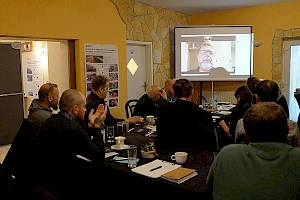Resilience through regional cooperation? Value creation from agroforestry systems with fast-growing tree species
12.12.2023

What role can agroforestry play in the future for the regional and decentralized supply of renewable resources? What possibilities are there for further processing and utilization? Where are there already players in Brandenburg and Saxony who are involved in the value chain?
In order to discuss the variety of cooperative relationships between producers and buyers of agricultural timber for the establishment of regional material and value-added cycles, 29 farmers, municipal representatives, entrepreneurs and industry partners interested in agroforestry met with practice-oriented researchers from the AgroWertRegio, Wertvoll and OLGA as well as the German Association for Agroforestry - DeFAF and the Saxon State Office for Agriculture and Geology.

The current strategic plan of the EU's Common Agricultural Policy (CAP) assumes that the area of agroforestry on German fields will be around 200,000 ha by 2026. In December 2023, this figure is currently around 56 ha. So there is still a lot to do: How can we get more agroforestry on the land in the future? To do this, we need courageous and committed farmers, but also - to stay with the wood value chain - municipalities and energy suppliers who buy the wood from farmers and feed it into their local or district heating networks in the form of wood chips.
After introductory presentations on the advantages of agroforestry in general and the legal framework for the establishment and maintenance of agroforestry systems in Brandenburg and Saxony, farmer Thomas Domin and Tobias Peschel from the planting company Lignovis GmbH reported on their practical experience: there are no

limits to the various cultivation/planting formats and the associated diversification of value creation. They are geared towards the environmental conditions at the location and the economic interests of the farm: whether in strips linked to the farm's own crop rotation, over a large area, as a chicken forest or in coexistence with valuable woods and/or shrub crops - the fast-growing tree species planted for wood use, such as poplar or willow, are very frugal. Once they have been planted, they can bind a lot of CO2 on the potentially available land in Germany and lead it into new cycles. What is needed now is creativity, economic diversification and a little optimism and courage!
Two workshop sessions were held to discuss the framework conditions for establishing a regional value chain for wood from agroforestry and possible opportunities for cooperation in establishing systems, maintenance and wood harvesting. Farmers want security in the form of long-term lease agreements with wood purchase guarantees of up to 15 years. For example, Energy Crops GmbH, a subsidiary of Vattenfall AG, concludes such long-term cooperation agreements with agricultural businesses for Berlin's heat supply.

The farmer leases the land and prepares the soil, while Energy Crops assumes the costs and risk for planting, maintenance, harvesting and transportation. In addition to these offers from the industry, a municipality, a local energy company or a cooperative can also work together with agriculture. Thomas Pöge, Mayor of Thallwitz/Wurzener Land, was connected online and explained how multi-use concepts can form the basis for long-term cooperation between municipalities and farmers.
For the future, it is important to clarify that the establishment and use of agroforestry systems is legally regulated by the CAP and that there is nothing to fear if you dare. Agroforestry systems should be understood and communicated as land use systems with numerous advantages and a relatively long lifespan - even beyond the use of wood for energy or material purposes. In addition to the yield benefits, services to promote biodiversity, soil structure and adaptation to climate change play a major role here. With a view to the value chain of wood from agroforestry with fast-growing tree species, municipalities should seek more dialog with their farmers. There is great potential here in terms of a more independent municipal and CO2-neutral heat supply with wood from the field.
